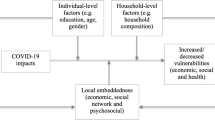Abstract
The chapter explores how the COVID-19 pandemic has revealed the complex inter-dependencies and obligations that exist between Somali refugees and their relatives in diaspora that go beyond the value of remittances for those in poor countries. Drawing on network analysis, I demonstrate that although the pandemic impacted negatively on people’s ability to send remittances, it also threw into relief the extent to which those in diaspora relied on their refugee relatives for emotional and social support. COVID-19 considerably weakened refugees’ economic standing, but it did not render them helpless. There were many positive stories of resilience amid the gloom occasioned by the pandemic as people resorted to culturally-based mechanisms of coping with and even appropriate their difficult circumstances. The chapter contributes to debates on migration, kinship networks, and remittances by highlighting the strength and adaptability of refugees in the face of the pandemic’s dire impact. This is a departure from recent literature that has mostly emphasized the vulnerabilities that have been occasioned by COVID-19.
Access this chapter
Tax calculation will be finalised at checkout
Purchases are for personal use only
Similar content being viewed by others
References
Abdi, C. (2015). Elusive jannah: The Somali diaspora and a borderless Muslim identity. University of Minnesota Press.
Abdulsamed, F. (2010). Somali Investment in Kenya. Briefing paper, The Royal Institute of International Affairs. www.chathamhouse.org.uk
Agamben, G. (1998). Homo sacer: Sovereign power and bare life. Stanford University Press.
Barnes, J. A. (1969). Network and political process. In J. C. Mitchell (Ed.), Social networks in urban sections (pp. 51–76). Manchester University Press.
Dirie, N. (2011) Somalia: Far from being failed state? BBC News Africa
Gellner, E. (1969). Saints of the atlas. University Press.
Gellner, E., & Munson, H., Jr. (1995). Segmentation: Reality or Myth? The Journal of the Royal Anthropological Institute, 1(4), 821–832.
Goldsmith, P. (1997). The Somali impact on Kenya, 1990–1993: The view from outside the camps. In H. M. Adam & R. Ford (Eds.), Mending Rips in the sky: Options for Somali communities in the 21st century (pp. 461–483). The Red Sea Press.
Herz, M. (2008). Somali refugees in Eastleigh, Nairobi. In H. Wright (Ed.), Instant cities. Black Dog Publishing.
Horst, C. (2006). Transnational nomads: How Somalis cope with refugee life in the dadaab camps of Kenya. Berghahn Books.
Hyndman, J. (1996). Geographies of displacement: Gender, culture and power in UNHCR refugee camps, Kenya. Ph.D. Thesis, The University of British Columbia.
Ikanda, F. N. (2019). Forging associations across multiple spaces: How Somali kinship practices sustain the existence of the Dadaab Camps in Kenya. In J.D. Schmidt, L. Kimathi, & M.O. Owiso (Eds.), Refugees and forced migration in the Horn and Eastern Africa: Trends, challenges and opportunities. Springer.
Ikanda. (2018). Somali refugees in Kenya and social resilience: Resettlement imaginings and the longing for Minnesota. African Affairs, 117/469, 569–591.
IOM. (2021). Migration data portal: The bigger Picture. IOM. https://www.migrationdataportal.org/themes/remittances. Retrieved November 12, 2021.
Kunz, R. (2011). The political economy of global remittances: Gender, governmentality, and neoliberalism. Routledge.
Lewis, I. M. (1999). A pastoral democracy: A study of pastoralism and politics among the Northern Somali of the Horn of Africa. Transaction Publishers.
Lindley, A. (2010). The early morning phone call: Somali refugee’s remittances. Berhahn Books.
Lochery, E. (2012). Rendering difference visible: The Kenyan state and its Somali citizens. African Affairs, 111(445), 615–639.
Markakis, J. (1987). National and class conflict in the Horn of Africa. Cambridge University Press.
Mitchell, J. C. (1974). Social networks. Annual Review of Anthropology, 3, 279–299.
Pandolfi, M. (2008). Laboratory of intervention: the humanitarian governance of the postcommunist Balkan territories. In M. D. Good, S. T. Hyde, S. Pinto & B. J. Good (Eds.), Postcolonial disorders. University of California Press.
Van Velsen, H. U. E. T. (1973). Coalitions and network analysis. In J. Boissevain & J. C. Mitchell (Eds.), Network analysis. Studies in Human interaction (pp. 219–250). The Hague
World Bank. (2016). Migration and remittances factbook 2016. The World Bank.
World Bank. (2020). Migration and development brief: Covid-19 crisis through a migration Lens 33. World Bank.
World Bank. (2021). Migration and development brief 34. Resilience: Covid-19 crisis through a migration lens. World Bank.
Acknowledgements
I acknowledge the financial support I received from the German Development Institute (DIE) to conduct fieldwork at the Dadaab camps in 2021. My deepest gratitude goes to my informants at Dagahaley camp.
Author information
Authors and Affiliations
Corresponding author
Editor information
Editors and Affiliations
Rights and permissions
Copyright information
© 2025 Intergovernmental Authority on Development
About this chapter
Cite this chapter
Ikanda, F.N. (2025). Remittances and Kinship Obligations in the Era of COVID-19: Case of Somali Refugees at the Dagahaley Camp in Kenya. In: Owiso, M.O., Tufa, F.A., Hersi, A.M. (eds) Migration and Displacement in the IGAD Region. International Perspectives on Migration(). Springer, Singapore. https://doi.org/10.1007/978-981-97-6611-6_12
Download citation
DOI: https://doi.org/10.1007/978-981-97-6611-6_12
Published:
Publisher Name: Springer, Singapore
Print ISBN: 978-981-97-6610-9
Online ISBN: 978-981-97-6611-6
eBook Packages: Social SciencesSocial Sciences (R0)




